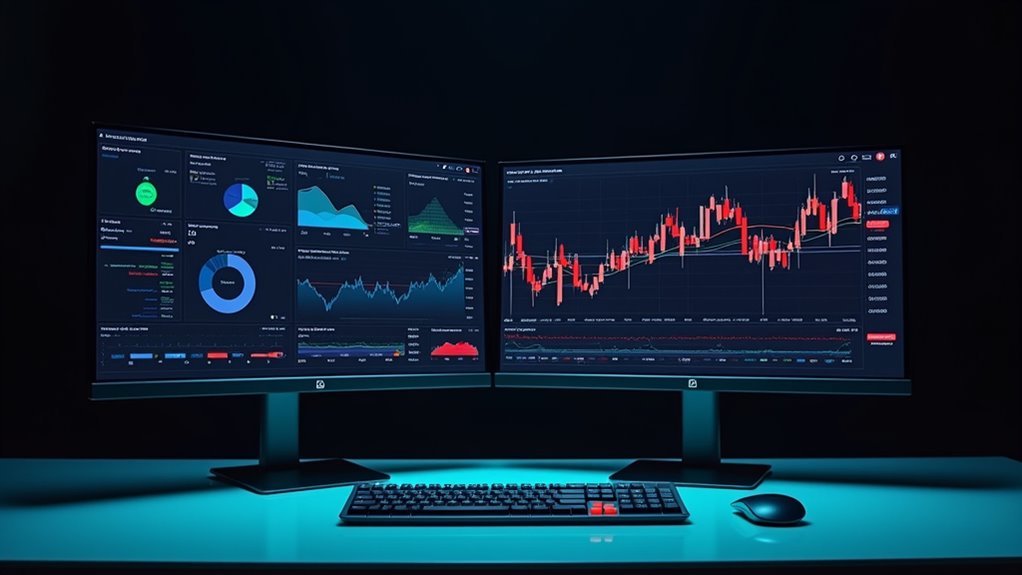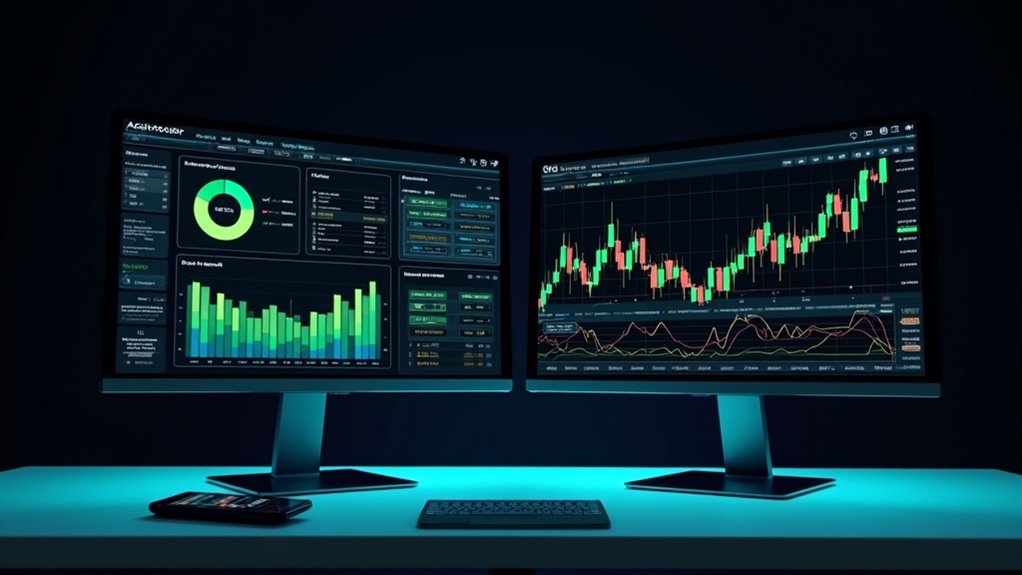Modern investment tracking relies heavily on digital tools that do the heavy lifting. Portfolio management software provides real-time data, automated monitoring, and instant alerts when stocks make significant moves. These systems integrate directly with brokerage accounts, track performance against benchmarks, and handle tax calculations – no more spreadsheet headaches. Security features like two-factor authentication keep financial data locked down tight. The tools available today make portfolio management less about guesswork and more about precision.

Money never sleeps, and neither does modern investment tracking. Today’s investors have an arsenal of digital tools at their disposal, from sophisticated portfolio management software to mobile apps that put real-time market data in their pockets. Gone are the days of pencil-and-paper ledgers. Welcome to the age of instant notifications and automated everything.
At the heart of any robust tracking system lies integration with brokerage accounts and customizable dashboards. These systems crunch the numbers on total returns, asset allocation, and individual security performance. And yes, they do it faster than any human could dream of. The real magic happens when live market feeds combine with automated alerts – imagine getting a ping every time your favorite stock makes a significant move. It’s like having a financial guardian angel, minus the wings and halo. The software’s streamlined data consolidation eliminates the need for manual entry across multiple accounts. Regular quarterly reviews help maintain optimal portfolio performance. Starting with a cash account provides a solid foundation for new investors learning the ropes.
Modern investment tracking is your digital financial companion, crunching numbers and monitoring markets with superhuman speed and precision.
Performance benchmarking keeps investors grounded in reality. Systems compare portfolio performance against major indices, peer groups, and historical data. It’s one thing to celebrate a 10% return; it’s another to realize the market averaged 15%. Ouch. Risk-adjusted calculations tell the complete story, not just the highlight reel.
Tax optimization features are the unsung heroes of investment tracking. These tools monitor capital gains, spot tax-loss harvesting opportunities, and generate those mind-numbing tax documents everyone loves to hate. They track dividend reinvestments and cost basis calculations with the precision of a Swiss watch. Because nobody wants to play guessing games with the IRS.
Security measures wrap everything in a protective digital blanket. Two-factor authentication, encryption protocols, and regular security audits keep financial data locked down tighter than a bank vault. In an age where data breaches make headlines weekly, this isn’t just nice to have – it’s essential.
The reporting tools tie everything together, generating customized reports and running what-if scenarios. Want to know how your portfolio would perform in a market crash? There’s a model for that. Need to analyze correlation between assets? Done. Modern investment tracking systems don’t just show where your money is – they show where it might go.
Frequently Asked Questions
How Often Should I Rebalance My Investment Portfolio?
Most investors rebalance annually – it’s the sweet spot between too much and too little.
Quarterly rebalancing can boost portfolio efficiency, but watch those transaction costs.
The 5% drift rule is popular: when allocations stray more than 5% from targets, it’s time to adjust.
Monthly? Usually overkill. Markets need breathing room.
Ultimately, it depends on portfolio size, goals, and market conditions.
What Tax Documents Do I Need to Track for Investment Reporting?
Investment tax tracking requires several key forms.
The 1099 series covers most bases – B for capital gains/losses, DIV for dividends, INT for interest income, and R for retirement distributions.
Schedule D and Form 8949 detail capital transactions.
Form K-1 shows partnership income.
Form 5498 tracks IRA activity.
Foreign investments? Form 1042-S comes into play.
Records should cover at least 3-7 years post-filing.
Yeah, it’s a lot of paperwork.
Should I Use Multiple Tracking Tools or Stick to One Platform?
The choice between multiple tools or a single platform depends entirely on portfolio complexity and management style.
Multiple tools offer deeper analysis and redundancy but require more time and money. Single platforms keep things simple and cost-effective but may lack specialized features.
Busy investors often prefer one all-encompassing platform. Investment nerds who love diving into data typically opt for multiple tools.
No right answer – just different strokes for different folks.
How Do I Track Investments Across Different Currencies and Markets?
Multi-currency portfolio trackers handle the heavy lifting.
These platforms convert holdings to a base currency, update exchange rates in real-time, and connect to thousands of financial institutions globally.
They aggregate data across stocks, bonds, crypto, and forex markets into one unified view.
Want performance metrics? They’ll spit out reports in any currency, complete with exchange rate impacts.
Pretty neat trick for global investing.
What Security Measures Protect My Financial Data in Tracking Systems?
Modern investment tracking platforms employ multiple layers of security.
End-to-end encryption protects data both in transit and storage, while multi-factor authentication prevents unauthorized access. Regular security audits catch vulnerabilities early.
Top platforms maintain SOC 2 and PCI DSS compliance – fancy terms meaning they follow strict security rules.
AI-powered monitoring systems detect suspicious activity 24/7, because hackers never sleep.








